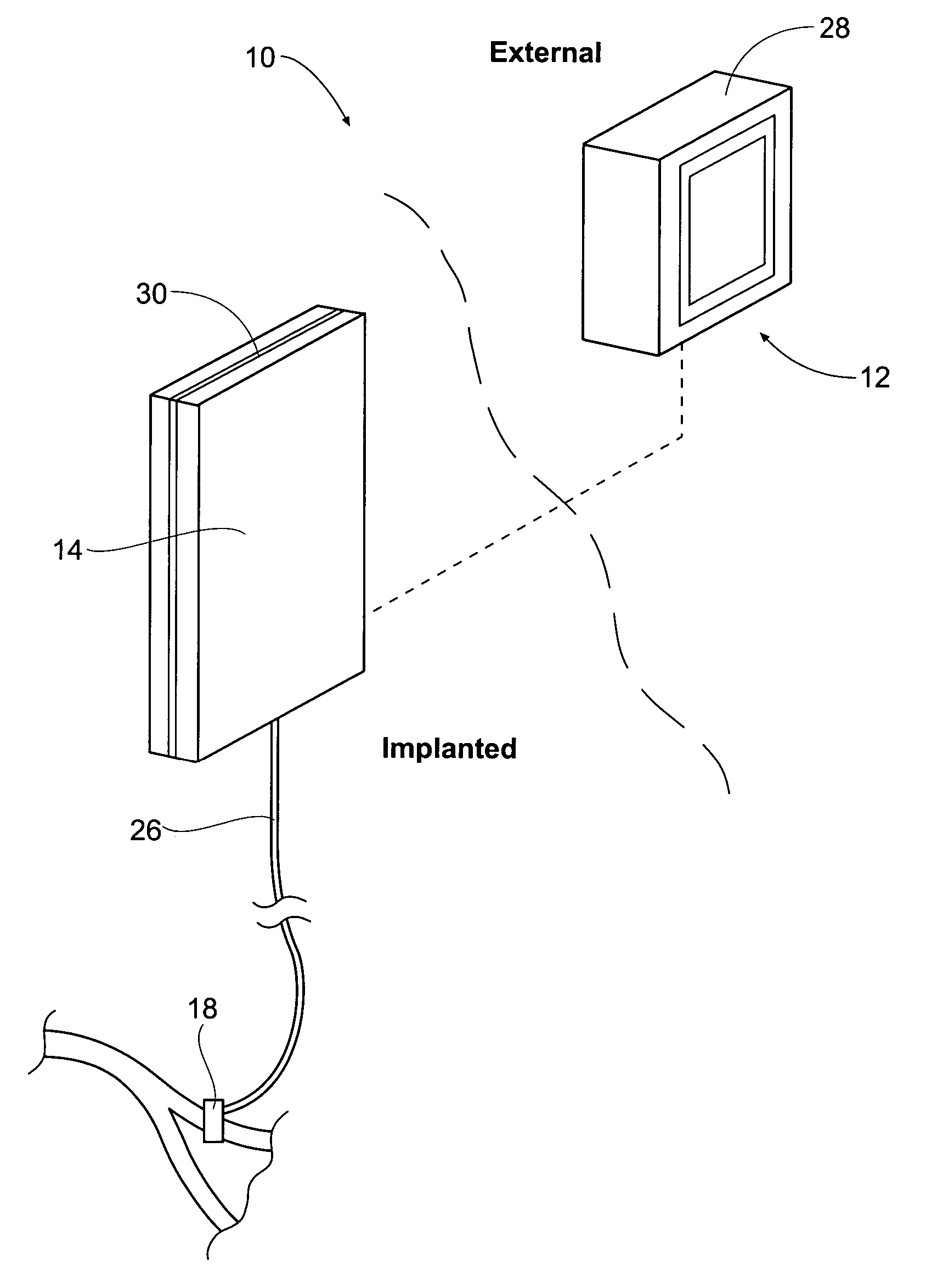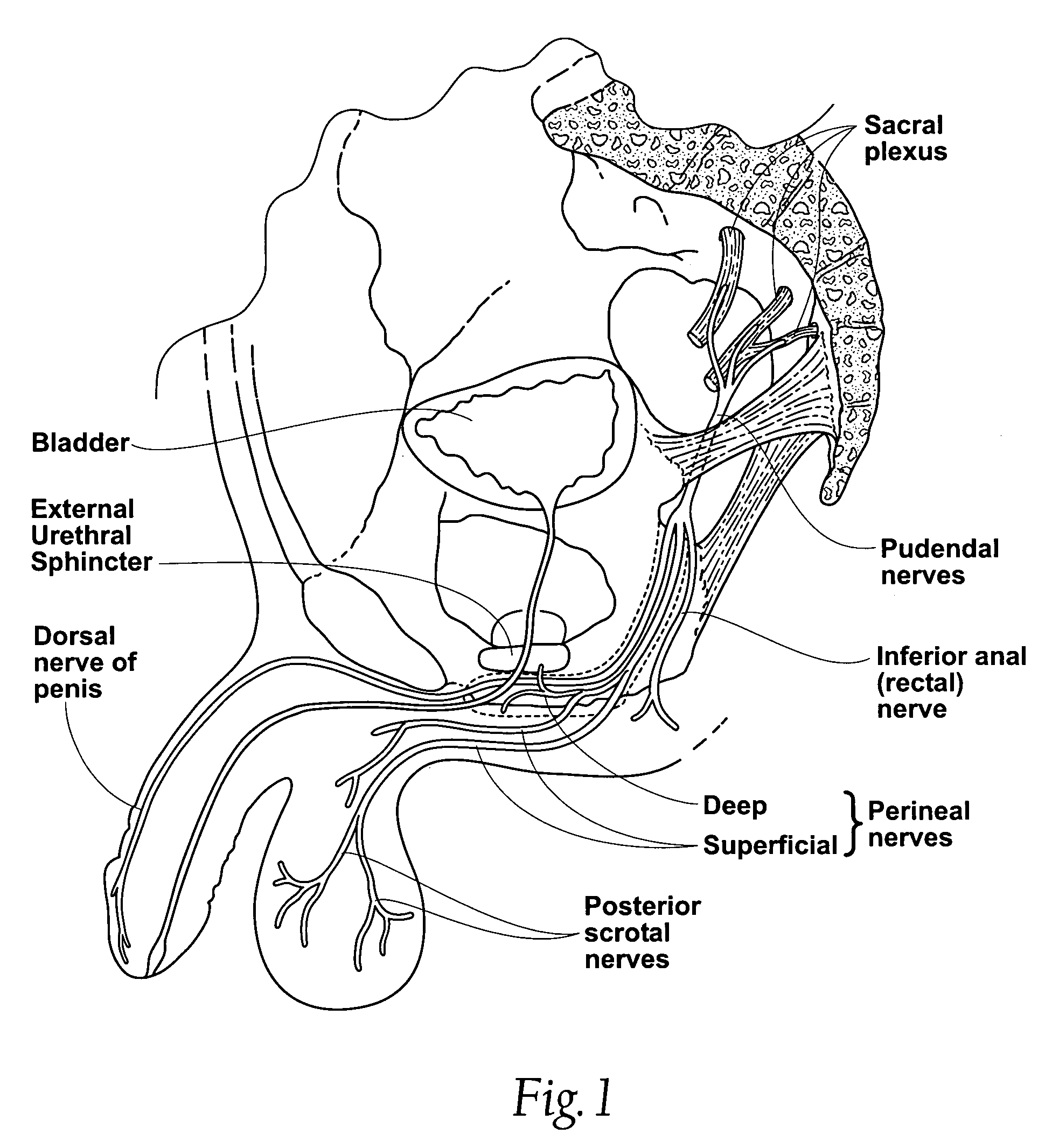Methods for stimulating components in, on, or near the pudendal nerve or its branches to achieve selective physiologic responses
a technology of pudendal nerve and component, applied in the field of systems and methods for stimulating nerves in animals, can solve the problems of inability to empty the bladder voluntarily, inability to function as a whole, and paralysis of the associated muscles
- Summary
- Abstract
- Description
- Claims
- Application Information
AI Technical Summary
Problems solved by technology
Method used
Image
Examples
example 1
[0034]Stimulation of afferent nerve fibers in the deep perineal nerve and the pudendal nerve in cats generates robust bladder contractions at high stimulation frequencies (i.e., greater than about 15 Hz), with an optimal frequency being near about 33 Hz. However, stimulation of the same afferent nerve fibers in the deep perineal nerve and the pudendal nerve in cats at lower stimulation frequencies (i.e., equal to or below 10 Hz) (given the same amplitude for the waveform), inhibits bladder contractions, or at least has no effect.
example 2
[0035]Stimulation of the urethral afferent nerve in cats generates robust bladder contractions at low stimulation frequencies (i.e., less than or equal to 5 Hz). However (given the same amplitude for the waveform), stimulation of the same afferent nerves in cats inhibits bladder contractions or has no effect at higher stimulation frequencies (i.e., greater than 10 Hz).
[0036]Traditional views hold that coordinated micturition (bladder contractions coupled with a reduction in activity of the external urethral sphincter) requires a spinal-brainstem-spinal reflex loop that is triggered by bladder distension. The data of Examples 1 and 2 indicate that stimulation of the urethral sensory nerve branch (USB) and / or afferent nerve fibers in the deep perineal nerve within one selected frequency range can evoke a micturition-like bladder contraction, leading to low-pressure continuous stream evacuation of the bladder on demand. The data also indicate that stimulation of the same urethral senso...
example 3
[0037]Intra-urethral stimulation in men with complete spinal cord injury at higher amplitudes and higher frequencies is more effective at evoking bladder contractions. With 2 Hz stimuli, bladder contractions were evoked in 0 / 4 trials at 5 mA, 0 / 4 trials at 10 mA, and ⅚ trials at 20 mA, and with 20 Hz stimuli, bladder contractions were evoked in ¼ trials at 5 mA, ⅔ trials at 10 mA, and 2 / 2 trials at 20 mA.
[0038]The data in Example 3 show that, as a general proposition, higher stimulation waveform frequencies (i.e., 20 Hz) can be more effective in evoking bladder contractions in humans than lower stimulation waveform frequencies (i.e., 2 Hz).
[0039]The foregoing Examples 1, 2, and 3 demonstrate that—in systems that apply the waveforms using electrodes placed in, on or near the pudendal nerve, and / or its branch(es), and / or its spinal root(s), including urethral afferents of the pudendal nerve and / or afferent nerve fibers in the deep perineal nerve, and / or afferent nerve fibers located i...
PUM
 Login to View More
Login to View More Abstract
Description
Claims
Application Information
 Login to View More
Login to View More - R&D
- Intellectual Property
- Life Sciences
- Materials
- Tech Scout
- Unparalleled Data Quality
- Higher Quality Content
- 60% Fewer Hallucinations
Browse by: Latest US Patents, China's latest patents, Technical Efficacy Thesaurus, Application Domain, Technology Topic, Popular Technical Reports.
© 2025 PatSnap. All rights reserved.Legal|Privacy policy|Modern Slavery Act Transparency Statement|Sitemap|About US| Contact US: help@patsnap.com



